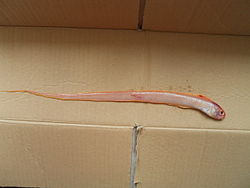| Cepola Temporal range: | |
|---|---|
 | |
| Cepola macrophthalma | |
| Scientific classification | |
| Kingdom: | Animalia |
| Phylum: | Chordata |
| Class: | Actinopterygii |
| Order: | Acanthuriformes |
| Family: | Cepolidae |
| Subfamily: | Cepolinae |
| Genus: | Cepola Linnaeus, 1764 |
| Type species | |
| 'Ophidion macrophthalmum' | |
| Synonyms [1] | |
Cepola is a genus of marine ray-finned fishes belonging to the bandfish family, Cepolidae. [2] The name red bandfish is applied to all members of this genus, but particularly C. macrophthalma, and generally not C. australis, which is also known as the Australian bandfish. [3]